This post may contain Affiliate Links. Please see my Disclaimer for more details.
This Haitian Stewed Chicken recipe produces a delicious, moist, and tender dish smothered in a tomato gravy that'll have your guest taste buds dancing and the potluck. I'm bringing this dish to this year's Black History Month Virtual Potluck.
Here are a few side dishes that'll taste incredible with this smothered in tomato gravy Jasmine Vegetable Rice, Air-Fried Sweet Plantains, Coconut Rice, or Garlic Mashed Potatoes.

Black History Month Virtual Potluck
In 2023, the theme of Black History Month is Black Resistance and Eat the Culture is recognizing the remarkable and, frankly, underrated resistance of our ancestors in bringing culinary traditions across the Atlantic to shape the vibrance of Black cuisine that we know and love today. They physically and mentally carried African foodways across the deadly Middle Passage to pass down through generations. This year’s Black History Month Virtual Potluck traces popular dishes of the Diaspora from their West African roots to North America and beyond.
You can grab the full list of recipes from this year’s collaboration on the Eat the Culture website.
Share these recipes with your friends and loved ones and follow each participant by using the hashtag #BHMVP2023 on Instagram.
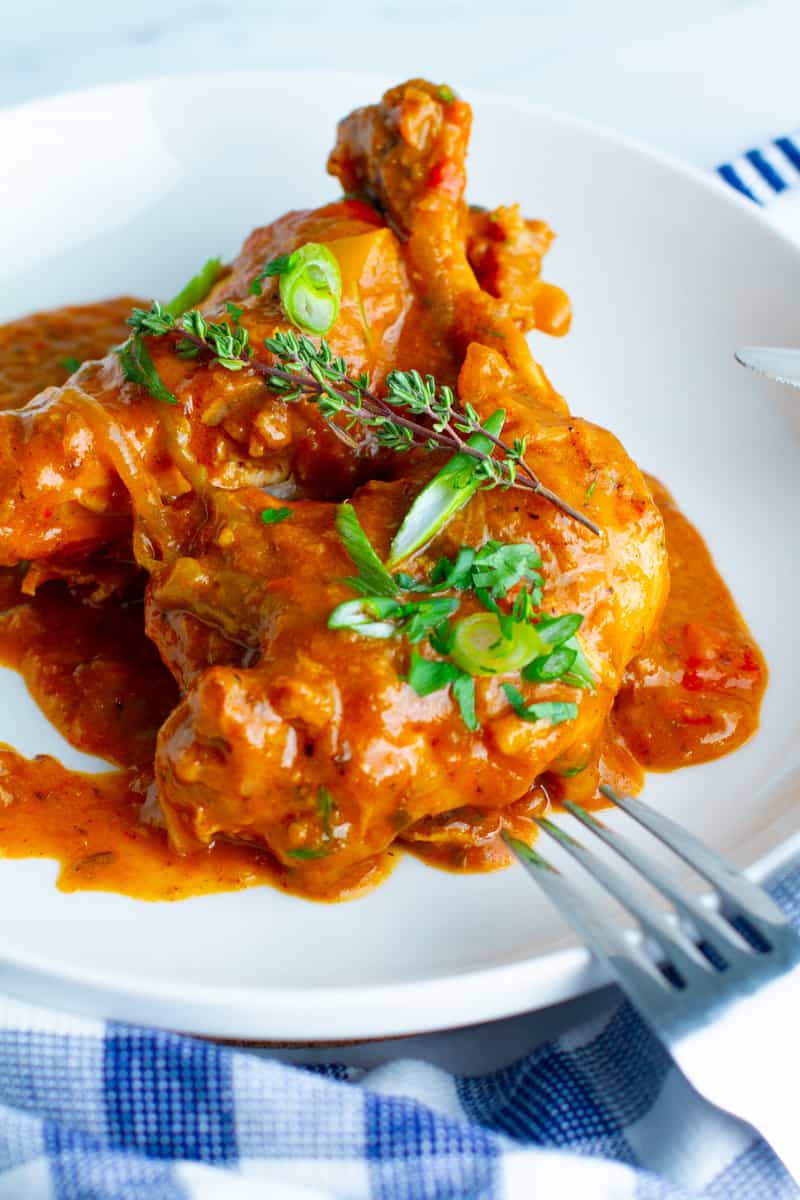
What Is Poulet Creole?
Poulet Creole, also known as poulet en sauce, means stewed chicken in creole sauce or Haitian stewed chicken in sauce. It’s the cousin of Mumba chicken.
Muamba chicken originated in Angola and has migrated with enslaved African people across the Caribbean, Central America, and the American South. This flavorful stewed chicken main dish combines spices and palm butter. Today, I’m teaching you how to make Poulet Creole from Haiti and encourage you to follow the story through Pollo Guisado (A Girl Called Adri) from Puerto Rico and Muamba Chicken (Flights and Food) from Angola.
If you’ve never cooked Haitian cuisine before, consider it the cousin of New Orleans Creole cuisine. That's not surprising considering that more than 10,000 Haitian were living in New Orleans by 1809 after fleeing during the Haitian revolution. The influx was so significant that it doubled the city's population.
While researching both cultures, I learned that the last name Burns and Dumas are Haitian names. I went to school with a large family of Burns, who I thought were just New Orleans Creole folks, turns out their Haitian Creole. I need to call my friend and find out if he knows.
Anyway, the connection is strong in many aspects, from carnivals (Mardi Gras) to architecture, dance and music, food, and religion.
My inspiration was to honor the Haitian cooking techniques but add my New Orleans twist. The recipe below is NOT 100% authentic Haitian, but it would make everyone who got a taste of this dish smile.
This stew chicken dish consists of chicken, vegetables, and herbs cooked in a tomato-based sauce. The creole sauce is made with bell peppers, green onions, garlic, thyme, scotch bonnets, and Cajun seasoning. Poulet creole is usually served with white rice or boiled plantains, and it's sure to tantalize your taste buds with its delicious and unique Haitian flavors.
Key Ingredients
Here are the ingredients you'll need for this fantastic Haitian food.
Chicken
I wanted to use whole chicken for this recipe, but you can use just chicken drumsticks. Please don't skip the washing the chicken step.
Haitian Epis
Epis is also known as Caribbean green seasoning. If you've never heard of it, think of Jamaican jerk paste; they're similar because both are packed with flavors but different.
Scotch Bonnet Peppers
This sweet African heat is fantastic. It's one of my favorite peppers to use, and I'll tell you how to add the same flavors if you cannot find the peppers locally.
Thyme
Fresh thyme is a must in Creole cooking.
Bell Peppers
We'll need three peppers for this dish, green bell pepper, yellow and red, but you can use orange too.
Tomato Paste
This will add color, body, and an umami flavor.
Chicken Stock
Most Haitian stew chicken recipes will call for chicken bouillon, but I personally don't like them (very high in sodium), so I just used a low sodium chicken stock.
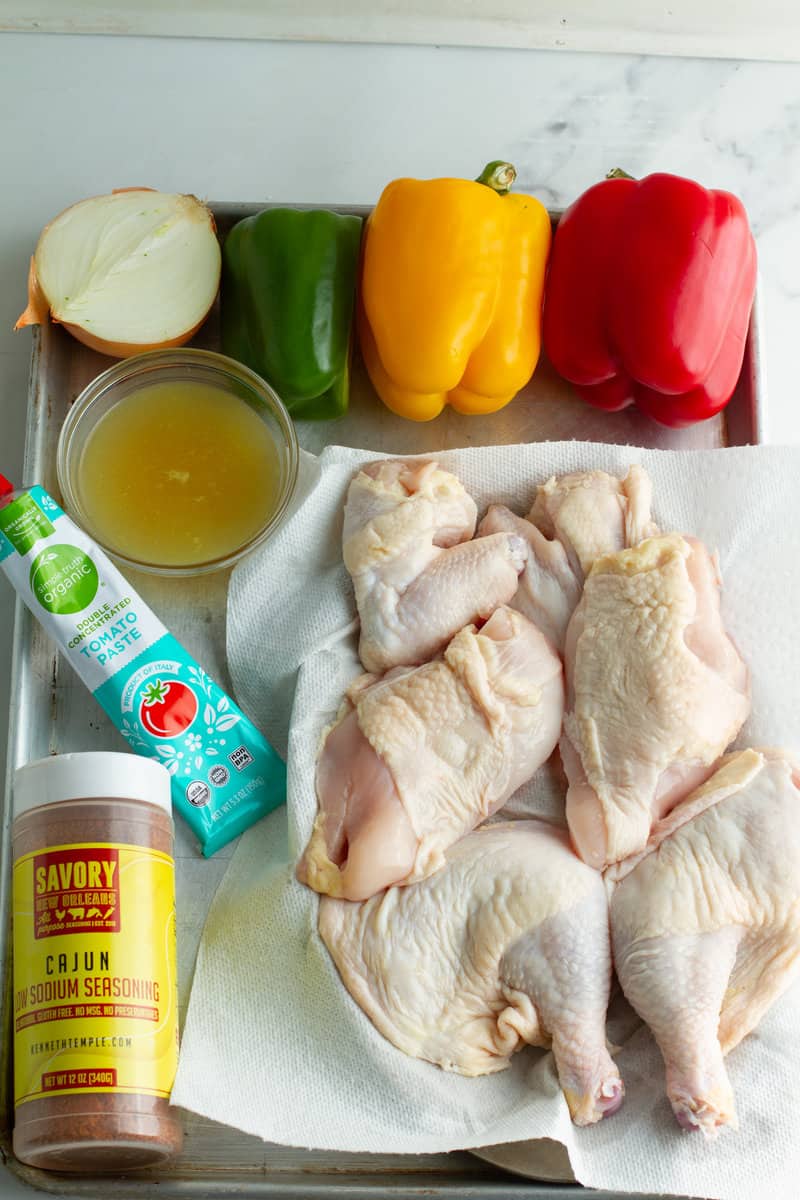
How To Make Haitian Chicken Stew Recipe?
Making Haitian chicken is not hard to prepare, but you do have to make everything with love and patience, so the flavors come signing throw the dish.
Haitian Epis
We cannot make this recipe without the wet marinade. I mean, you could, but then it wouldn't be poulet creole. You'll need a food processor or blender to chop everything down. Add green onions, garlic, parsley, thyme, scotch bonnet, bell pepper, onion, salt, cloves, stock, and oil in a blender. Pulse a few times until the marinade has a slightly chunky consistency, like pesto or chimichurri.
Stewed Chicken
Wash your chicken with vinegar or lime juice. Then pour hot water over it to clean it. Pour the epis over the chicken and marinate for 2 hours or overnight.
The next day, heat a large pot over medium heat with oil. While the oil gets hot, dredge the chicken lightly in flour, then cook for 3 minutes per side until golden brown.
In the same pot, cook the sliced onions and bell peppers for 3 minutes. Add tomato paste and Cajun seasoning and cook for 1 minute. Add the remaining marinade, stock and chicken, bring to a boil, cover and cook for 30 minutes, stirring occasionally.
Remove the chicken breast and continue cooking for 10 -15 minutes until the chicken thighs are fork tender. Serve chicken and creole sauce over rice with fried plantains, and enjoy!
That's how easy it is to make poule en sauce, aka poulet creole.
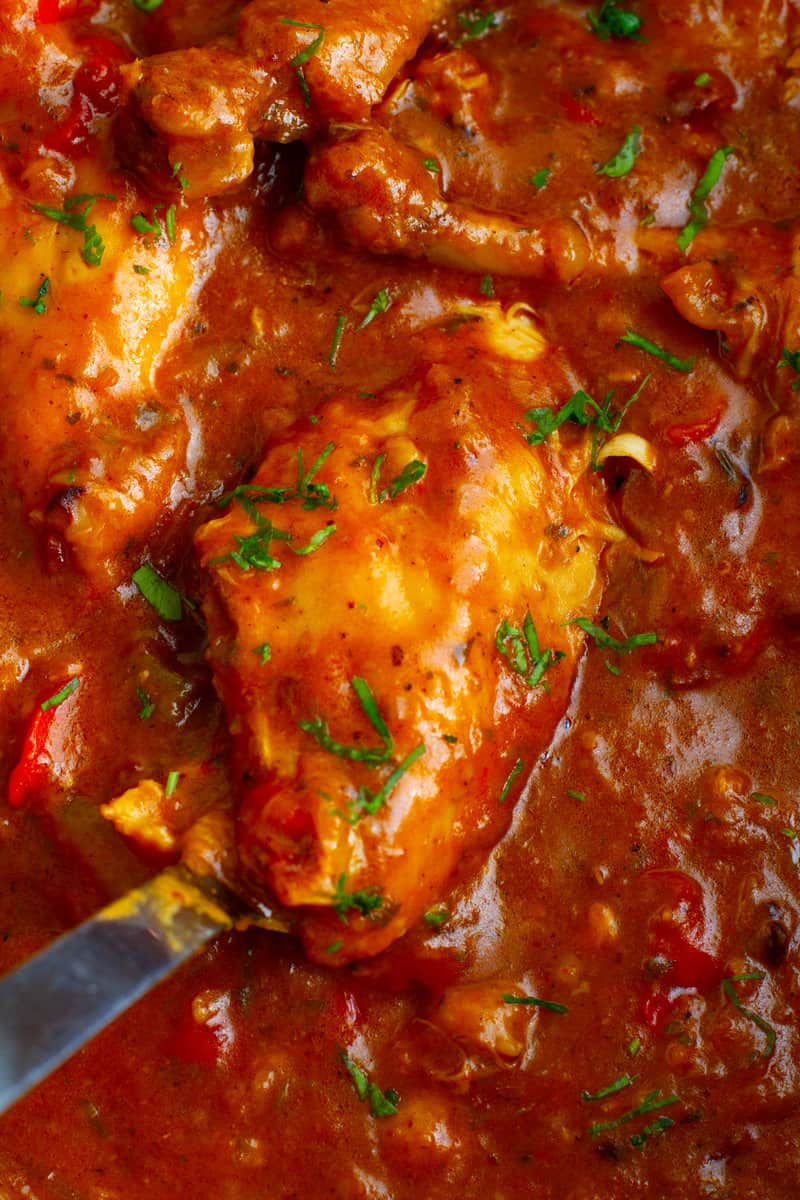
Pro Recipe Tips & Tricks
Here are the best practices, techniques, substitutes, and flavor builders you'll need for poulet creole en sauce.
- You can marinate the chicken for as little as 30 minutes. The longer you marinade, the deeper the flavor.
- You can use only chicken thighs, legs, or any piece of chicken instead of a whole chicken.
- If you cannot find fresh scotch bonnets in your local area, use 2 tablespoons of scotch bonnet hot sauce.
- You can skip using the flour; scrape the marinade off the chicken before frying in the oil. This will create a thinner gravy for your sauce.
- Feel free to use gluten-free flour as a swap for the all-purpose flour.
- I've seen epis range from green to a yellowish hue, so don't be alarmed if it turns out yellowish.
- You can omit the scotch bonnet if you don't like spicy food.
- If you don't have any Cajun seasoning, just use kosher salt and black pepper.
- If you want to avoid wasting tomato paste, opt for the ones in tubes instead of cans - this way, any unused product won't go to waste!

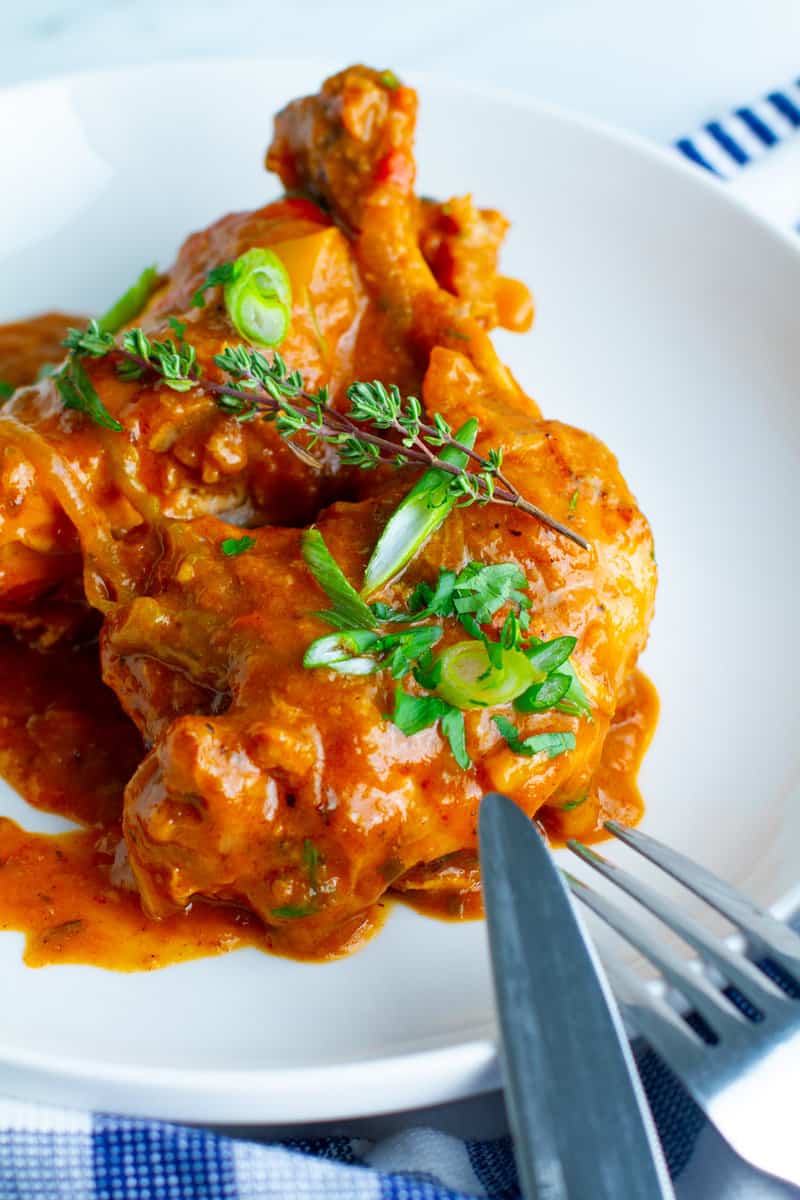
FAQs
Here are the top questions readers have about Haitian stewed chicken.
Before you start preparing Haitian chicken, it is crucial to make sure you clean the chicken properly. To clean Haitian chicken, begin by rinsing it thoroughly with vinegar or lime juice. Then, carefully trim off any fat or slimy pieces of skin that may be on the surface of the chicken. After that, use a sharp knife to remove any organs or other inedible parts from inside the bird's cavity. Finally, pat dry with a paper towel, and you're ready to start cooking Haitian chicken.
Thickening stew chicken is a great way to add extra flavor and texture to the dish. The most common method of thickening stew chicken is using a roux or slightly dredging the chicken in flour, and the flour will thicken the stew as it cooks.
Another common way to thicken stew is to add a mixture of cornstarch and water – this creates a slurry that can be stirred into the stew to make it thicker. Both methods will thicken your chicken stew nicely, so choose whichever works best for you!
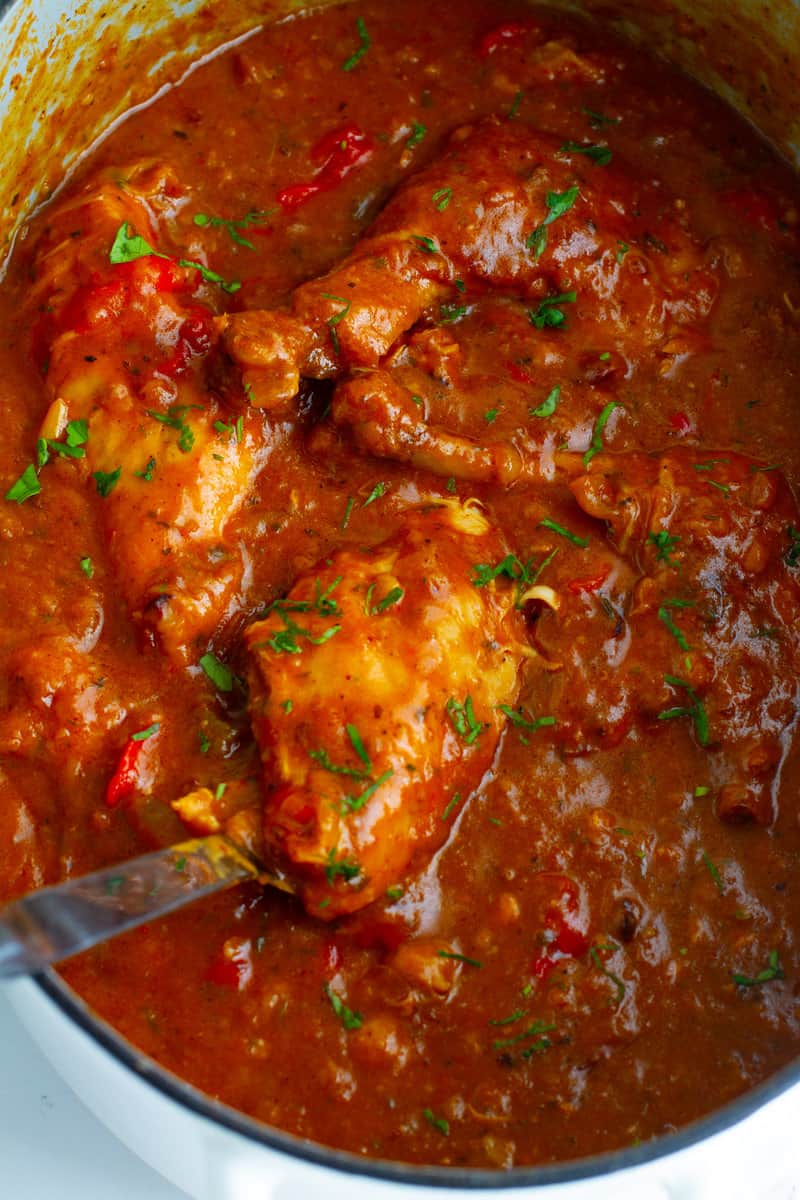
How to store Haitian Chicken Stew?
Haitian chicken stew is best eaten immediately but will remain fresh in an airtight container for 7 days in the fridge.
Place cooled chicken in an airtight container freezer safe and freeze for 3 months. Thaw 24 hours before reheating.
To reheat Poulet creole, reheat over medium heat with ½ cup of stock to thin out the gravy; cook for 8-10 minutes or until hot.
Latest Recipe Video:

Before You Begin
Here are my steps for getting organized before I start anything.
Step 1: Get all ingredients for the Haitian chicken stew on the counter.
Step 2: Measure everything out into individual bowls.
Step 3: Start following the recipe and get ready for the best Haitian stewed chicken (poulet creole) you've ever enjoyed.
I hope you enjoyed this delicious Haitian Stewed Chicken recipe! I'm sure your family and friends will love it too. If you tried out the dish, leave a comment below with your star rating and let me know how it turned out! And don't forget to share this amazing recipe with your loved ones on social media so they can enjoy it as well.
Click here to subscribe to MY NEWSLETTER for easy and free recipes right into your inbox!
To pin this recipe and save it for later, you can use the Pin button on the recipe card, the sharing buttons above or below this post, or any of the photos above.
Tag me @kennethtemple_ and use #LezEat on Instagram to share your remakes with me, and don't forget to leave a star rating and comment below.
📖 Recipe

Haitian Stewed Chicken (Poulet Creole)
Ingredients
Haitian Epis Marinade:
- 3 green onions chopped
- 4 garlic cloves smashed
- ¼ cup chopped Italian parsley
- 4 sprigs of fresh thyme
- 1 scotch bonnet halved
- ½ medium green bell pepper chopped
- ½ medium onion chopped
- 2 teaspoons kosher salt
- ½ teaspoons ground cloves 10-12 whole cloves
- 2 tablespoons white vinegar
- ¼ cup chicken stock
- ½ cup olive oil
Poulet Creole:
- 1 whole chicken washed and cut into 8 pieces
- ½ cup white vinegar
- 3 cups boiling hot water
- 1 tablespoon Savory Cajun seasoning
- 3 tablespoons oil
- 1 ¼ cup unbleached all-purpose flour
- ½ medium onion sliced
- 1 red bell pepper sliced
- 1 yellow bell pepper sliced
- 2 tablespoons tomato paste
- 2 ½ cups low sodium chicken stock
Instructions
Haitian Epis Marinade:
- In a food blender or processor add green onions, garlic, parsley, thyme, scotch bonnet, bell pepper, onion, salt, cloves, stock and oil. Pulse 8-10 times until marinade has a chunky sauce consistency like pesto. Pour over cleaned chicken then pop in fridge for 2 to 8 hours. Remove the chicken from the fridge 15 minutes before cooking.
Poulet Creole:
- Remove access fat and skin from chicken with a small knife or kitchen shears then pierce all over then wash in white vinegar. Place in a colander and pour hot water over it. Drain and then place in a storage bag with marinade.
- Heat oil in a large Dutch oven over medium heat. Add flour to a plate and lightly dredge each piece of chicken before frying in hot oil. Cook chicken for 3 minutes per side. Set aside.
- Add onion and bell peppers, cook for 3 minutes, Cajun seasoning, tomato paste and cook for 1 minute. Add marinade, stock, and chicken to pot, bring to a boil, cover slightly and reduce heat to low for 35-45 minutes, stir occasionally until chicken is fork tender. The breast will be done near 30-35 minutes, remove to avoid drying them out. Serve chicken with sauce over rice, grits, fried plantains or with a green salad.
Notes
- You can marinate the chicken for as little as 30 minutes. The longer you marinade, the deeper the flavor.
- You can use only chicken thighs, legs, or any piece of chicken instead of a whole chicken.
- If you cannot find fresh scotch bonnets in your local area, use 2 tablespoons of scotch bonnet hot sauce.
- You can skip using the flour; scrape the marinade off the chicken before frying in the oil. This will create a thinner gravy for your sauce.
- Feel free to use gluten-free flour as a swap for the all-purpose flour.
- I've seen epis range from green to a yellowish hue, so don't be alarmed if it turns out yellowish.
- You can omit the scotch bonnet if you don't like spicy food.
- If you don't have any Cajun seasoning, just use kosher salt and black pepper.
- If you want to avoid wasting tomato paste, opt for the ones in tubes instead of cans - this way, any unused product won't go to waste!


Takera says
The history is so interesting. I didn’t realize the Haitian connection to New Orleans. This recipe sounds mouthwatering, the marinade, then frying before stewing, it sounds really packed with flavor. I’m looking forward to giving this one a try.
Kenneth Temple says
I hope you enjoy it Takera!